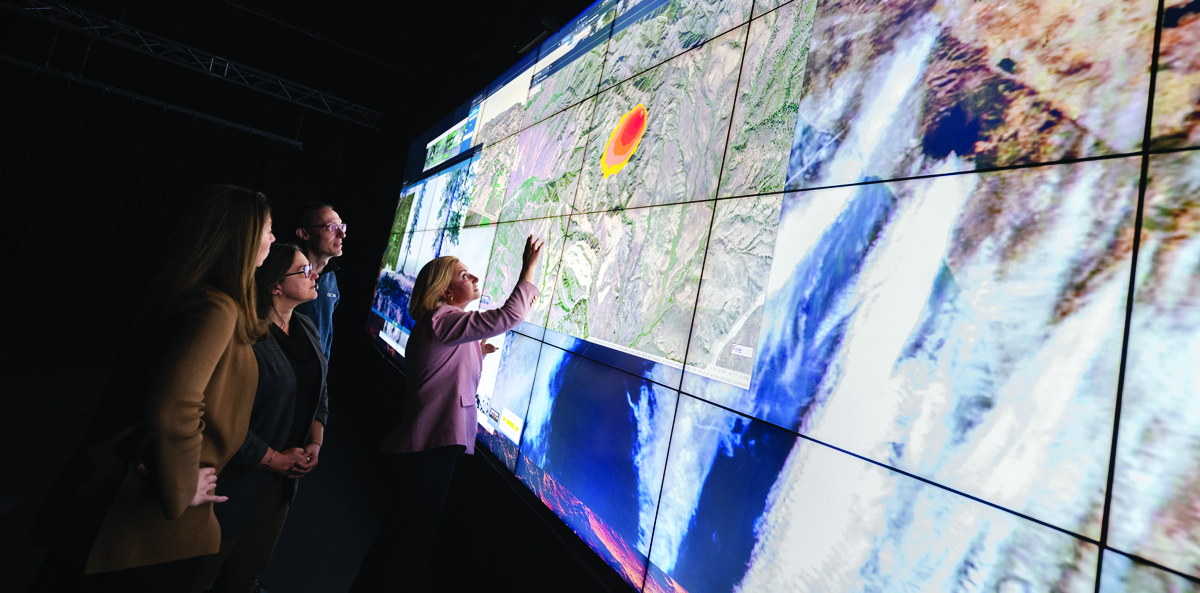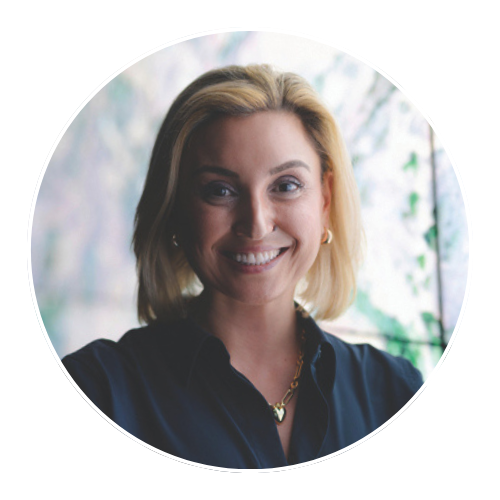Building a Collaborative Future for Computing and Broad Innovation
Driven by a passion for interdisciplinary collaboration through computing, Ilkay Altıntas, Ph.D., Chief Data Science Officer, San Diego Supercomputer Center (SDSC) at University of California San Diego School of Computing, Information and Data Sciences; Division Director, Cyberinfrastructure and Convergence Research; Founding Director, Societal Computing and Innovation Lab (SCIL), has forged a career that bridges science and innovation. With an early fascination for algorithms and systems that make sense of data, her work spans diverse fields, from computer science and high energy physics to environmental and biomedical data science, and is grounded in a central passion: using computational tools to address complex, real-world challenges. These experiences have become the foundation for her continued leadership in cyberinfrastructure innovation, where she now focuses on building platforms that enable broad scientific communities to collaborate more effectively.
Creating Scalable Solutions
Joining SDSC in 2001, Altintas has been a principal investigator and a technical leader in a wide range of cross-disciplinary projects. She specializes in scientific workflows and data platforms, and orchestrates collaborative efforts that turn complex data challenges into scalable, reproducible, and reusable solutions that help advance the reach and impact of computational data science.
“My path has been transformed through my engagement with researchers in environmental and biomedical fields and finding new ways to harness data and computing for urgent challenges, including wildland fire modeling, the genomic data analysis, and time series analysis of variables.” shares Altintas. "Working side by side with domain scientists has helped me to understand how infrastructure innovation can accelerate impact, especially when it's co-designed with users. We work together to understand the problem and create a scalable solution.”
This hands-on, team-oriented mindset was reinforced early in her career by mentors who not only supported her cross-disciplinary exploration, but also modeled a deeper principle of leadership in service of community-driven innovation. “There’s a whole set of things that need to be modeled and to understand how to add your own two cents to what is learned,” reflects Altintas. “That ethos of contributing meaningfully while staying grounded in community needs has become my north star. Whether developing scientific workflows, enabling open science, mentoring future leaders, or addressing societal challenges through data, I want to remain focused on creating positive, responsible impact. Innovation should not only be scalable and efficient, but also ethical and broadly applicable.”
With a focus on making advanced computing and cyberinfrastructure more usable and accessible, Altıntas aims to support domain experts who are tackling complex, data-intensive problems, whether they’re scientists, researchers, students, or decision-makers. “At SDSC’s SCIL, we focus on building composable systems where our data science tools, workflows, high performance computing (HPC), and scalable computing resources are seamlessly integrated. This enables platforms where users don’t need to be experts in HPC to run scalable analyses. Whether it's genomics, environmental modeling, or social science, the goal is to let users focus on their science, not the underlying technology.”
To make this possible, Altıntas’ team develops end-to-end workflows that simplify technical complexity while keeping solutions flexible. These workflows are designed with usable, accessible agentic AI interfaces that allow domain experts to engage directly with powerful infrastructure. “With the alternative backends and composable services in the backend, we work closely with scientists to co-design these workflows and tools, often integrating Jupyter based environments, containerization, or automated data pipelines to streamline processing,” explains Altıntas. “By building trust and partnerships, and aligning cyberinfrastructure innovation with user needs, you’re able to create solutions that are meaningful and enable discovery at scale.” Altintas is the PI of the National Science Foundation (NSF)-funded National Data Platform, which was built around such an approach, filling a critical gap to enable AI-integrated innovation on top of today's research infrastructure landscape.
Integrating Collaborative Hazard Sciences
The WIFIRE Lab is a consortium of UC San Diego organizations and a number of partnerships including the university collaborators, industry partners, fire departments, utilities, and agencies like California Governor's Office of Emergency Services (CalOES), and CAL FIRE. To help respond to natural disasters like wildfires and other hazards, the WIFIRE Program has created a digital twin that connects all the steps from collecting data to creating models that predict what might happen next. As the only integrated infrastructure that can currently provide this capability, it can serve as a trusted, neutral partner for any group or project that needs accurate, up-to-date hazard information.

WIFIRE team members, led by Ilkay Altintas (far right), integrate many data sources to model wildfire behavior, providing real-time predictive maps to first responders. (Photo by Erik Jepsen, UC San Diego)
“WIFIRE became the first example of using real-time data modeling to bridge the gap between advanced research and real-world decision making and provide tools for fire and land management,” explains Altıntas. “We've built systems that combine real-time data, artificial intelligence (AI), and scientific models to help people respond to wildfires more effectively. These tools are designed for fire managers, emergency responders, and land managers, and put powerful technology directly into their hands. For example, tools like Firemap and BurnPro3D use 3D visuals to quickly show what’s happening on the ground through sensing and combine it with physics-based fire behavior models. They can also predict where a fire is going and help plan safe, controlled burns in advance.”
Since 2018, these tools have been used in real wildfire situations across California and in prescribed fire operations across the country, including Colorado and other states. “Through a demo network, the tools have helped improve coordination between teams and supported faster, data-informed decision-making for both active fire and fire mitigation efforts,” says Altintas. “WIFIRE has built this collaborative model on strong, trust-based relationships with fire agencies, researchers, communities, and partners across all sectors to ensure the solutions we develop are useful and sustainable. I think this approach has been key to our success and this collaboration is essential for expanding to other hazards or any form of societal scale integration of solutions that need to be co-produced.”
Looking ahead, the WIFIRE program is actively adapting this model to support responses to other cascading hazards. “We work within California and other states to determine how our model and technology can be used for floods, landslides, and an air quality crisis,” explains Altintas. “We aim to explore how real-time data and predictive tools can empower decision-makers in meaningful ways. Our goal is to build a flexible, interoperable infrastructure and platform that can adapt to a wide range of situations and keep the needs of the communities it serves at the center.”
Developing a Skilled Data Science Workforce
For Altintas, advancing data science isn’t just about building tools, it’s also about empowering people. A major focus of her work is developing a skilled, socially aware data science workforce who are prepared to tackle real-world challenges. "Over the past few years, we’ve created several programs aimed at this goal," explains Altintas. "We started with WIFIRE and also led a group of principal investigators in the NSF Convergence Accelerator track to establish what we now call the Convergence Institute. The institute brings together cross-sector participants and helps them understand how innovation happens at the intersection of science, technology, and society. We also started a new lab called the Societal Computing and Innovation Lab (SCIL) which serves as a hub for educational programs and workforce development that center on data science for the societal good.”
Altintas says building this workforce requires more than just technical skills. “Developing a skilled data science workforce starts with creating learning environments that are inclusive, interdisciplinary, and connected to real-world challenges. The best way to build data science skills is by using them in practice and we must empower people not only to work with data, but to use it ethically and effectively in service of their communities. By co-developing educational resources and tools with the communities, students, researchers, and practitioners don’t just learn from the system, they help shape it. When we co-develop training materials with individuals who represent the needs of their own environments, the solutions and the learning are directly relevant.”
“All of our training is coming from collaborative thinking and pairing learners with domain experts and technologists to help them navigate the how and why of data science,” continues Altintas. “We’re trying to generate scientific impact, societal impact, and educational impact. That means not only enabling people to do the work, but helping them understand why it matters. Mentors play an important role in promoting active learning and helping students understand the purpose behind their work. It’s not enough to build tools or run projects; it’s about cultivating a deeper sense of meaning and responsibility in those who use them. We do not just train data scientists, our goal is to develop problem solvers who can work across disciplines, communicate effectively, and who can co-create solutions within the community.”
Promoting Interdisciplinary Collaboration
Interdisciplinary collaboration is essential for turning complex technical solutions into real-life impact, but creating these connections is much more than just bringing experts together. “It takes real work to create a shared purpose and form mutual respect,” says Altintas. “You need to care about what others are doing, rather than just focusing on your own work. Collaboration rooted in shared goals and respect creates the foundation for trust, which in turn enables long-term partnerships. It’s important to align on why the work matters—rather than just how it’s done. This requires listening to domain experts, understanding their pain points, and deciding which problems are uniquely solvable with science and technology.”
Once those challenges are identified, Altintas says it’s crucial for the group to invest time in building a common language and shared frameworks to effectively address them together. “We discuss data and knowledge systems, modular workflows, collaborative platforms, and ensure that everyone can engage meaningfully in the process, regardless of their technical background. Translating technical solutions into real-world impact requires more than just delivering a finished tool, it demands ongoing engagement, adaptation, and learning through demonstration networks and operationalization of research. In the lab, we also focus on creating models for adoption, training, and continuous iteration based on user feedback to scale it further into the world.”
In her leadership role at SDSC, Altintas serves on the executive team, helping to shape strategy and guide a wide range of data science initiatives. She also plays a central role in developing SDSC’s approach to artificial intelligence, working with colleagues to craft a forward-thinking AI strategy. “My vision for a research institute like SDSC is that we serve both as enablers and accelerators,” shares Altintas. “By enabling discovery through accessible infrastructure and accelerating impact through innovation and collaboration, SDSC can act as both a platform and a catalyst for meaningful scientific and societal progress. We can create the connective tissues between cutting-edge technology and application and accelerate adoption across the diverse scientific communities that need it most. Our role is not just to host infrastructure, but to build ecosystems of capabilities and services and engagement programs where innovation is accessible, ethical, and responsive to scientific and societal needs.”
Supporting interoperability and rapid experimentation with emerging technologies also requires a strong focus on workforce development, as well as a commitment to replicability, reproducibility, and accessibility. “We must continue to serve as conveners across disciplines through building all types of engagement and link academia, industry and governments to create cross disciplinary, cross sector, use-inspired research,” notes Altintas. “Developing new models for innovation is still needed and is the reason behind founding the SCIL. We must continue to develop more alternative, adaptable models that can drive innovation across different domains.”
With the growing influence of AI and the emerging potential of quantum computing, Altintas says research institutes and centers like SDSC will need to be trusted guides who can ground innovation in rigorous science and help with the adoption of these advanced technologies. “Collaboration happens not just among builders of computing systems, but also with users, educators, and across sectors. At SDSC, this collaborative spirit is deeply ingrained in our culture. The center strives to broaden its user base and remain responsive to their evolving needs, all with the ultimate goal of enabling transformative solutions for both science and society.”
Anchoring Solutions in Community
To help ensure that a broader range of communities and institutions can benefit from advanced technologies and knowledge, Altintas notes the key role regional research and education networks (RENs) play in connecting users to critical infrastructure, expertise, and collaborative opportunities. “RENs, like Edge and CENIC, act as vital connectors, not just in terms of network capacity, but bridging communities of practice within research institutions, community colleges, and other organizations within the research and educational landscape. RENs reduce those barriers to entry for institutions that may otherwise be left out of national scale research initiatives.”
“RENs also understand local challenges and can tailor support accordingly, whether that is providing access to advanced computing, facilitating training programs, or brokering partnerships within local organizations and industry and public-private partnerships,” continues Altintas. “They help raise awareness of available resources and create multiplier effects by enabling smaller institutions to connect with a larger ecosystem of innovation and discovery. When these organizations gain access to advanced research tools and methods, they’re better equipped to develop solutions tailored to the unique challenges of their local communities.”
In looking ahead, Altintas envisions a future where cutting-edge science and technology are harnessed to tackle society’s most complex, high-impact challenges. “My hope is to pioneer new pathways for solving problems that can only be addressed through the unique capabilities of advanced research, especially through our work at SCIL. One of the biggest questions is: how do we bring research into solutions at the speed that the challenges are growing? Wildfire response, for instance, demands real-time, data-driven decisions. But the same need for agility applies to evolving landscapes, patient care, and public health crises. The challenges may differ, but the need for responsiveness is constant. That’s where technologies like AI, edge computing, and digital twins come in and can enable solutions that are as dynamic as the problems they’re meant to solve.”
Altintas’ approach builds on years of developing cyberinfrastructure, scientific workflows, and AI systems in close collaboration with communities. “My goal now is to broaden the user base and deepen cross-sector partnerships, creating a model of innovation that is agile, broadly applicable, and scalable,” says Altintas. “However, we’re not replacing experts. We want to augment practical and scientific knowledge and use data and technology to generate, test, and apply that knowledge more effectively. By anchoring solutions in community needs and designing with responsiveness in mind, we hope to help shape a future where science truly meets society in real time.”
“We structured SCIL around the opportunity to turn science and technology into something usable and create products, platforms, and pathways that actually deliver impact,” continues Altintas. “This includes embedding open science and co-production at every stage, not as an afterthought, but as a foundation. Open doesn't mean everything goes, but if we can prioritize co-production and openness within a thoughtful framework at every stage of innovation, then we’re not just building tools, we're building trust, equity, and usability.”
With a vision that is bold and future-focused, Altintas is reimagining the process and partnerships that drive innovation with the goal of creating infrastructure, platforms, and ecosystems that can truly adapt to the complexities of the real world. “We must design with purpose, partner with communities, and make sure the science we build works for everyone. This is what inspires me every day when I come to work, having the opportunity to build together and enable innovation and discovery that is more deeply rooted in the needs of society.”
“Ilkay Altintas exemplifies what it means to be a visionary leader at the intersection of data science and societal impact,” says Dr. Forough Ghahramani, Associate Vice President for Research, Innovation, and Sponsored Programs, Edge. “Her work—whether advancing wildfire modeling through WIFIRE or training the next generation of researchers—is helping reshape how we think about cyberinfrastructure as a tool for equity, resilience, and discovery. We are proud to shine a spotlight on her in EdgeDiscovery and grateful for her commitment to inclusive innovation.”

